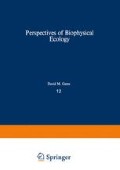Abstract
The abundant flowers of a compressed summer in the mountains provide an energy resource for exploitation by hummingbirds. However, the cold nights constitute a liability in their total energy budget. Adiabatic cooling, clear dry air, and the heat sink of the cold sky result in chilling conditions for the incubation of eggs by a tiny hummingbird. Howell and Dawson (1954) recorded the ability of the Anna’s hummingbird (Archilochus anna) to maintain homeothermy while incubating overnight. I was greatly impressed the first time that I saw an even smaller calliope hummingbird (Stellula calliope) incubating her eggs in the presunrise cold of Jackson Hole, Wyoming. In a later visit I was equipped to record temperatures from two calliope nests. They also maintained homeothermy all night, despite the colder climate (Calder, 1971), stimulating my interest in heat-exchange principles and problems. It was obvious that ornithologists had given little consideration to physical factors in bird behavior, and that further study of hummingbird nesting would be rewarding. The population of broad-tailed hummingbirds (Selasphorus platycercus) at Gothic, Colorado, has been ideal for this. Evidence of the marginal energetic situation for this population may be seen in the occasional recourse to hypothermia during incubation (Calder and Booser, 1973) and the abandonment of live, normal chicks at some late nests when the flower supply declines, simultaneous with influx of competing migrant hummingbirds, in late July and early August (Calder, 1973d). Thus energy conservation in thermoregulation is of major importance.
Access this chapter
Tax calculation will be finalised at checkout
Purchases are for personal use only
Preview
Unable to display preview. Download preview PDF.
References
Aschoff, J, Pohl, H.: 1970a. Rhythmic variations in energy metabolism. Federation Proc. 29, 1541–1552.
Aschoff, J, Pohl, H.: 1970b. Der Ruheumsatz von Vögeln als Funktion der Tageszeit und der Körpergrösse. J. Ornithol. 111, 38–47.
Calder, W. A.: 1971. Temperature relationships and nesting of the calliope hummingbird. Condor 73, 313–321.
Calder, W. A.: 1973a. The consequences of body size for avian energetics. In Avian energetic (ed. R. A. Paynter, Jr.). Cambridge, Mass.: Nuttall Ornith. Club, (in press).
Calder, W. A.: 1973b. An estimate of the heat balance of a nesting hummingbird in a chilling climate. Comp. Biochem. Physiol. 46A, 291–300.
Calder, W. A.: 1973c. Microhabitat selection during nesting of hummingbirds in the Rocky Mountains. Ecology 54 (1), 127–134.
Calder, W. A.: 1973d. The timing of maternal behavior of the broad-tailed hummingbird preceding nest failure. Wilson Bull. 85, 283–290.
Calder, W. A., Booser, J.: 1973. Hypothermia of broad-tailed hummingbirds during incubation in nature with ecological correlations. Science 180(May 18), 751–753.
Drent, R.: 1972. Adaptive aspects of the physiology of incubation. Proc. XV Intern. Ornith. Congr., 255–280.
Drent, R.: 1973. The natural history of incubation. In Breeding biology of birds (ed. D. S. Farner), pp. 262–311. Washington, D.C.: Natl. Acad. Sci.
Hainsworth, F. R., Wolf, L. L.: 1972. Crop volume, nectar concentration, and hummingbird energetics. Comp. Biochem. Physiol. 42, 359.
Howell, T. R., Dawson, W. R.: 1954. Nest temperatures and attentiveness in the Anna Hummingbird. Condor 56, 93–97.
Kleiber, M.: 1961. The fire of life. New York: Wiley.
Lasiewski, R. E.: 1963. Oxygen consumption of torpid, resting, active and flying hummingbirds. Physiol. Zool. 36, 122–140.
Lasiewski, R. E.: 1964. Body temperatures, heart and breathing rate, and evaporative water loss in hummingbirds. Physiol. Zool. 37, 212–223.
Lasiewski, R. E. Dawson, W. R.: 1967. A re-examination of the relation between standard metabolic rate and body weight in birds. Condor 69, 13–23.
McNab, B. K.: 1971. On the ecological significance of Bergmann’s rule. Ecology 52, 845.
Porter, W. P., Gates, D. M.: 1969. Thermodynamic equilibria of animals with environment. Ecol. Monogr. 39, 227–244.
Tucker, V. A.: 1971. Flight energetics in birds. Am. Zool. 11, 115–124.
Veghte, J. H., Herreid, C. F.: 1965. Radiometric determination of feather insulation and metabolism of Arctic birds. Physiol. Zool. 38, 267–275.
Editor information
Editors and Affiliations
Rights and permissions
Copyright information
© 1975 Springer-Verlag New York Inc.
About this chapter
Cite this chapter
Calder, W.A. (1975). Factors in the Energy Budget of Mountain Hummingbirds. In: Gates, D.M., Schmerl, R.B. (eds) Perspectives of Biophysical Ecology. Ecological Studies, vol 12. Springer, Berlin, Heidelberg. https://doi.org/10.1007/978-3-642-87810-7_24
Download citation
DOI: https://doi.org/10.1007/978-3-642-87810-7_24
Publisher Name: Springer, Berlin, Heidelberg
Print ISBN: 978-3-642-87812-1
Online ISBN: 978-3-642-87810-7
eBook Packages: Springer Book Archive

